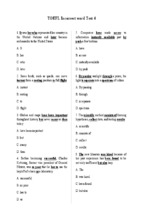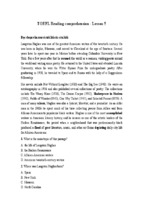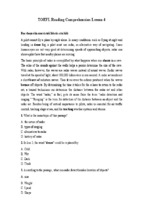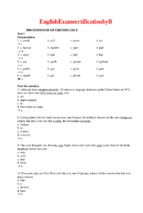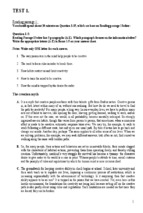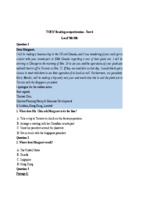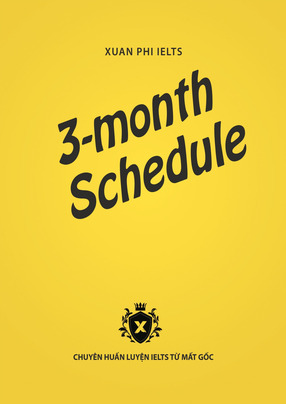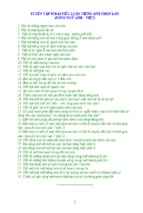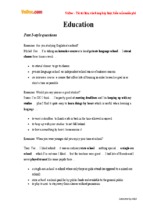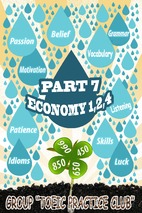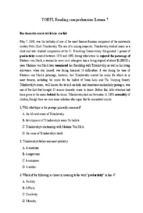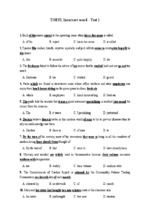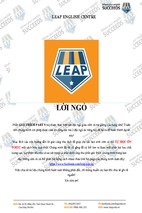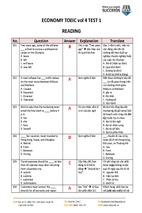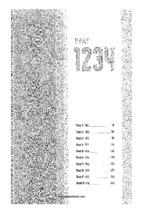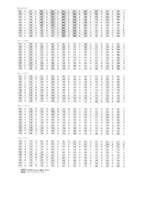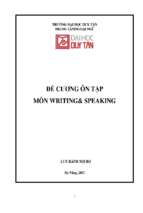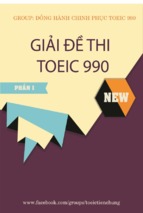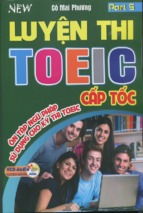IELTS READING TIPS
1. IELTS Academic Reading: Basic Information
The Reading Test is immediately after the Listening Test at 10.40am. You do not get a break.
There are 3 sections in the Reading Test. Each section has 13 or 14 questions, making 40
questions in total. The test lasts 60 minutes, and in that time you must write your answers on an
answer sheet.
Here are some of the problems students have with IELTS Reading:
Time is the biggest problem. Many students don't manage to finish the test.
The texts are long and contain some difficult vocabulary.
Students find "paragraph headings" questions difficult.
Students find "true/ false/ not given" questions difficult.
IELTS Reading is really a test of your vocabulary. If your knowledge of English words and
phrases is good, you will do well.
There are techniques that can help you to work faster and cope with the difficult question types.
However, the best way to improve your IELTS Reading score is by doing a lot of reading and
vocabulary work.
Page 1
IELTS READING TIPS
2. ELTS Reading: Simon’s advices
1. Don't read the whole text; you haven't got enough time. Just go straight to the questions.
2. 'Paragraph' questions are much easier if you do them last. Do other sections first.
3. The answers to most questions should be in the correct order in the text, so you don't
need to go back to the beginning to start looking for the next answer.
4. Read all instructions carefully.
5. Look for 'keywords'. There are usually words in the questions that are similar to words
you need to find in the text. For example, if the text contains the word "global", the
question might use the word "international". If you find the similar words, you have
probably found the answer.
6. You must get to the end and answer every question. If you don't finish, you might miss
some easy points.
7. Some questions are difficult because their aim is to separate band 8 and band 9. Don't
waste time on difficult questions. Miss them, finish the exam, and return to them at the
end.
3. IELTS Reading: some suggestions
People often ask me for advice about how to improve their reading. Here are some suggestions:
1. If you want to improve your reading, the first thing to do is read a lot. There are no
shortcuts or secret techniques; you will only improve with time and practice.
2. Anything you read in English is good practice, so read about subjects that interest you.
Try to enjoy reading in English.
3. English is the most used language on the web. Whenever you search for information on
the Internet, try searching in English first.
4. Remember that "understanding is not the same as using". Keep a notebook with useful
words and phrases that you find when you're reading, and try using them in your own
sentences.
5. Apart from reading things that interest you, you also need to read lots of IELTS
passages. If you've done all of the tests in the Cambridge books, read the passages
again without doing the questions. Use a dictionary, take notes, and try to fully
understand each passage.
6. Another way to use the Cambridge tests is to look at the correct answers to each
question first. Your task is to find out why those answers are correct by analysing the
passage carefully and finding the 'keywords'.
Page 2
IELTS READING TIPS
I'm sure you can think of other suggestions. Be creative with your reading practice, try to enjoy
the learning process, and trust that you will improve if you persist.
4. IELTS Reading: time
'Not having enough time' is the biggest problem for most people taking the reading test. Here are
some tips for dealing with this problem:
1. Go straight to the first question. Don't waste time reading the full passage or the first
sentence of each paragraph, and don't read any of the other questions.
2. Do 'paragraph' questions last. Questions that ask you to match headings or statements
with paragraphs are much easier if you are already familiar with the passage.
3. Don't get stuck on one question. As soon as you realise that you are having difficulties
with a question, leave it and move to the next one. Return to difficult questions later if
you have time.
4. Remember that the answers to most question sections are in order in the passage. You
don't need to go back to the beginning of the passage to search for each answer.
5. Only skim or scan for numbers and names. Otherwise, read at normal speed.
6. Work with an alarm. You can't do this in an exam, but at home you could set the alarm
(on your phone) for 2 minutes and try to do each question within this time.
Note:
When preparing for the reading test at home, try not to worry about time at first. Your first
concern should be to get the score you need, even if it takes you 3 hours instead of 1 hour to do a
full test.
5. IELTS Reading: paragraph headings
Here are my top 4 tips for how to answer 'paragraph headings' questions:
1. Do these questions last
'Paragraph headings' questions are difficult, especially because the answers will not be in order in
the text. For most other types of question, the answers will be in order in the text. So, do the
other questions first, then you will be familiar with the text when you return to the 'paragraph
headings' questions. You might even find that you are able to match some of the paragraphs
really quickly because you remember what they were about.
2. Start with the shortest paragraphs
Instead of starting with the first paragraph, why not start with the shortest paragraph? If there is a
really short paragraph, it should be easier to match it to a heading. Then you will have fewer
headings to choose from for the longer paragraphs.
Page 3
IELTS READING TIPS
3. Look for similar words
As with most types of IELTS reading question, you should be able to find words in the paragraph
that are similar to words in the heading.
4. Move on if you are spending too much time
'Paragraph headings' questions often take a long time. Don't allow yourself to use more than 20
minutes for each reading passage. If you haven't finished after 20 minutes, move on to the next
passage.
6. IELTS Reading: which paragraph contains...?
"Which paragraph contains the following information?" This type of question is notthe same as
"match the headings to the paragraphs".
Here are some tips for "which paragraph contains?" questions:
Instead of looking for the main idea of each paragraph, you need to find one piece of
information.
Some paragraphs might not contain any answers.
The same paragraph might contain more than one answer.
It's not usually difficult to understand the question or answer, but it is difficult
to find the answer.
Do these questions last. By doing other questions first, you will become familiar with
the passage, and you might remember where some of the answers are.
Look for the easiest information first: questions that contain names, numbers or
big/unusual words might be easier to find.
7. IELTS Reading: false or not given?
Students are often confused by the difference between 'false' and 'not given'.
You should choose false if the information in the passage directly contradicts the question
statement; in other words, you need to be able to show that a different answer would be true.
Choose not given only when there is no information, or not enough information.
8. IELTS Reading: match the names
One type of question asks you to "match the names with a statement". You will see a list of
people's names (often researchers or experts) and you have to match each name with a statement
about what he/she did or said.
Here's some advice for this type of question:
Page 4
IELTS READING TIPS
1. Find all of the names in the passage first. Scan the whole passage quickly (don't read it,
just search for the names) and underline all the names that the question asks you
about.
2. Remember that academic articles often only use surnames. For example, if one of the
names is Robert Smith, you might not see the first name 'Robert' in the passage. Just
look for the surname 'Smith'.
3. Do difficult questions last. If one name is mentioned 3 times in 3 different paragraphs, it
will be more difficult to match with a statement than a name that is only mentioned
once. Start with the name that is only mentioned once.
4. When you find a match, put a cross next to the statement; you will only use each
statement once.
5. As usual, look for "keywords" - words in the passage that are similar to words in the
question statements.
9. IELTS Reading: easy questions first
A good technique for the IELTS reading test is to do easy questions first. If you get stuck on
difficult questions, miss them. Do the easy questions, then return to the tricky questions later.
What's the easiest type of question?
The easiest type of question is probably any question that contains a name, number or date. For
these questions, it should be easy to scan the text to find where the answer is.
If you find it difficult to get started in the exam, look for a question with a name, number or date,
and start there. An easy question will help you to start confidently.
12.IELTS Reading: skimming and scanning?
Many teachers and books talk about skimming and scanning as key techniques for IELTS
reading.
I have stopped using the words 'skimming' and 'scanning' in my lessons because I find that they
confuse students. In fact, many students get the wrong answers because they 'skim' too quickly
and miss the words that they are looking for.
So, forget 'skimming' and 'scanning' and focus on 'finding' and 'understanding'.
1. Finding: read the text to find words from the question.
2. Understanding: when you have found some key words from the question, read that
part of the text carefully in order to understand it and get the right answer.
13. IELTS Reading: 2 questions about exam technique
Page 5
IELTS READING TIPS
1. Should you read the whole passage before looking at the questions?
2. Should you go to the questions first, then skim/scan to find the answers?
My answer to question 1 is no. You don't have time to read the whole passage unless your
English is almost 'native speaker' level.
My answer to question 2 is yes and no.
Yes - go to the questions first.
No - don't skim or scan unless the question contains a name or number.
My advice is to do the questions one by one. Instead of skimming or scanning, read the passage
carefully. The answers to most question sections will be in order in the passage, so you will
gradually read the whole passage as you find the answers.
14. IELTS Reading: finding and understanding
IELTS reading is really a test of 2 things:
1. Can you find the part of the text that contains the answer?
2. Do you understand that part of the text?
Finding
You need to be able to find the right part of the text quickly. I practise this a lot with my
students: we decide which words in the question we need to search for, then we try to locate
those words (or words with the same meaning) in the text.
Understanding
When you have found where the answer is, you need to read that part of the text carefully. Read
the sentences before and after the keywords that you found. Then it becomes a test of your
vocabulary knowledge: if you don't understand the words that you are reading, it will be difficult
to get the right answer.
Page 6
- Xem thêm -

